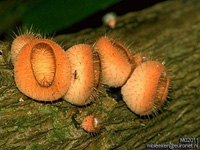





© Marco Bleeker, 1995-1998
Carbon is present in carbon-dioxide molecules in the atmosphere and also dissolved in water. It is disassociated from the oxygen during photosynthesis and incorporated into organic matter by chemical reactions. From here it is transported from one trophic level to another, by the food chain.
Carbon returns to the environment through respiration of producers, consumers and decomposers in carbon-dioxide form. It can, however, be removed or stored in the Earth's rocks for prolonged periods (millions of years) through fossilization and subduction processes. It is then re-released to the atmosphere in the form of carbon-dioxide, by volcanism.
Additionally carbon can be stored by life processes for periods of perhaps hundreds of years, by vegetation. The rainforests are one environment where this occurs, and they are very effective short-term receptacles for active carbon (ie non-fossilized carbon). The forests prevent it from forming carbon-dioxide and thus entering the atmosphere, where it can act as a greenhouse gas and help to absorb solar radiation - increasing global temperatures.
It is a common belief that the rainforests absorb excess carbon-dioxide. This is a fallacy. Rainforests by their very nature, already contain as much carbon as they can store. However, if the rainforests are destroyed the carbon reserve they maintain is released as carbon-dioxide. This contributes significantly to the "greenhouse effect", otherwise known as global warming. Destruction of the rainforests would increase the carbon-dioxide level in the atmosphere by 50%, which would have serious consequences for the climate and probably catastrophic consequences for mankind and modern civilization.
Go
to
Home
| Space Station
| Mars | Rainforest
© 1999 Satellite Events Enterprises Inc.